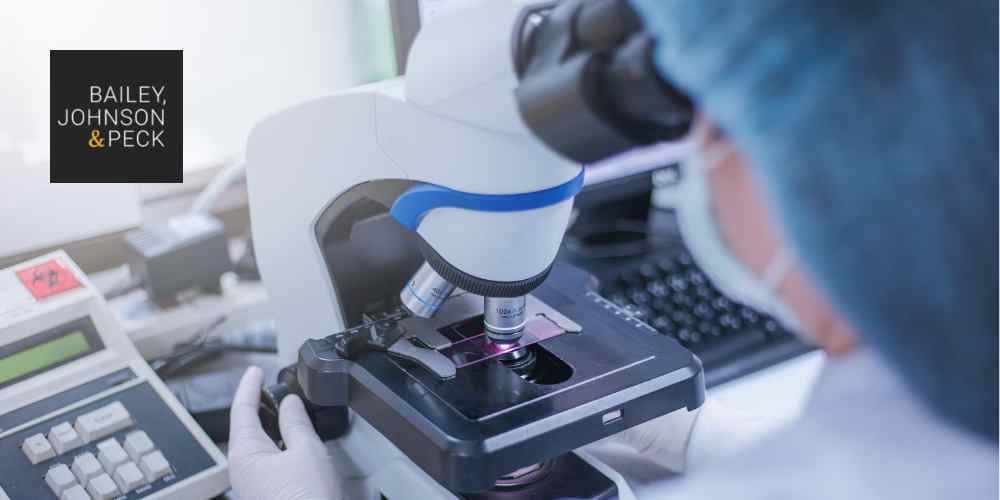Doctors are trained to diagnose and treat a wide range of medical conditions. Still, many health conditions have similar symptoms to other health conditions, making it hard for some patients to receive a correct final diagnosis. That’s why so many medical professionals compile a differential diagnosis to help move the diagnostic process along.
When doctors reach an incorrect diagnosis or fail to diagnose an issue in a timely manner, they could cause their patients to experience serious harm. If you or a loved one has suffered harm as a result of a missed, delayed, or incorrect diagnosis, the Albany medical misdiagnosis lawyers at Bailey, Johnson & Peck are here for you.
We can help you seek justice against the negligent medical professionals who caused you harm and ensure that you receive the financial compensation you deserve. Call us at 518-456-0082 to schedule a free consultation with a legal professional on our team.
What is Differential Diagnosis?
A differential diagnosis is a list of potential health conditions that a patient could be suffering from based on their symptoms. Many conditions share the same or similar symptoms, so by making a list of all of the possibilities, the doctor can go through and eliminate them one by one through various diagnostic tests.
When doctors have trouble making a diagnosis on a specific issue, they may use differential diagnosis to help narrow down the possibilities and, hopefully, definitively diagnose their patient with the correct condition. This form of clinical practice allows the patient to understand their current health situation and participate in the process of reaching a correct diagnosis.
What Does the Differential Diagnosis Process Look Like?

If a patient is struggling with a health condition and they have either not been diagnosed with anything or have been diagnosed and treated for the wrong thing, they may see a doctor. Sometimes, their condition may be hard to diagnose immediately, so their doctor will go through the differential diagnostic process to help conclude. To make a differential diagnosis, the doctor may:
- Ask the patient about their symptoms;
- Discuss the patient’s medical history and their family medical history;
- Discuss the patient’s past treatment attempts, if applicable;
- Perform a physical examination;
- Order diagnostic tests;
- Review test results and
- Evaluate symptoms over time.
If the patient has the symptoms of more than one health condition, creating a differential diagnosis and eliminating potential options can help them receive a correct diagnosis.
How the Differential Diagnostic Process Works
The differential diagnosis process involves a couple of different diagnostic methods. The process primarily involves a consultation about the patient’s medical history and family history, as well as a physical exam and a series of laboratory tests.
By the end of all of this, the patient will most likely have a correct diagnosis and a treatment plan for their specific disease or condition. If their doctor can’t come to a definitive conclusion, the patient may be referred to a specialist for further examination or treatment.
Evaluate the Patient’s Medical History
Evaluating the patient’s medical history is the first step in developing a differential diagnosis. The doctor may ask their patient about their symptoms, how long they have been experiencing them, and how debilitating they are. If the symptoms are severe, the underlying condition may also be severe.
The doctor may then ask about the patient’s medical history, like if they have experienced these symptoms before if there are other symptoms that they tend to experience and aren’t experiencing now, or if there is anything that triggers them to experience these symptoms. The doctor may also ask if anyone in their family has experienced these symptoms.
A complete patient and family history can help the doctor narrow down potential diagnostic tests. For example, if the patient’s mother has suffered from the same symptoms in the past, the doctor may be able to test for conditions with similar symptoms and known genetic factors.
Perform a Physical Examination
With informed consent, a doctor will also perform a physical examination to help determine if the patient’s condition is interfering with any of their vitals. The physical exam will often check the patient’s blood pressure, heart rate, and the sound of their lungs. If the underlying condition affects the patient’s blood pressure, heart rate, or lungs, that can help the doctor determine the cause of the symptoms.
Run Various Diagnostic Tests
After getting an idea of the patient’s medical history and performing their physical examination, the doctor can make a differential diagnosis list. From there, they can order various diagnostic tests to help eliminate one or more of the conditions on their differential diagnosis. Some of these tests can include laboratory tests, such as:
- Blood tests;
- Urine tests;
- Biopsy; and
- DNA tests.
They may also order one or more imaging tests, such as a:
- Magnetic resonance imaging (MRI) scan;
- Computerized tomography (CT) scan;
- Positron emission tomography (PET) scan;
- Ultrasound;
- X-ray; or
- Mammography.
After receiving the test results, the doctor will evaluate the results and cross-reference them with their suspected diagnosis list. If the patient does not have the diagnostic criteria of certain health conditions, the doctor can rule those options out of the differential diagnosis. This can help them zero in on a final diagnosis or force them to run more tests.
Refer the Patient to Specialists
After the differential diagnostic process is complete, the doctor will most likely be able to provide the patient with an accurate diagnosis. From there, the patient can start seeking treatment for their condition or conditions. If their primary care physician can’t treat their patient alone, they may refer them to a specialist who can help treat them.
If the patient’s condition can’t be determined through diagnostic tests and a physical exam, the doctor may recommend certain treatments anyway to see how the patient’s condition changes as a result. This can help further narrow down the possibilities and help them land a final diagnosis.
What Do the Results of Differential Diagnosis Mean?

At the end of the differential diagnosis process, patients will often receive a diagnosis of one or more medical conditions. From there, they can start seeing a healthcare provider who can treat them for their condition or conditions.
In today’s day and age, our medical knowledge is more advanced than at any other point in human history. Still, we don’t know everything about the human body or certain health conditions. If the results of a differential diagnosis are inconclusive, doctors may have to start from scratch or order further tests to eliminate possible errors made in the process.
If the doctor still can’t decide on a final diagnosis, they may refer their patient to another doctor who may be more equipped to help them.
Common Examples of Differential Diagnoses
Some general health symptoms can be associated with many possible conditions. Below are some examples of what a differential diagnosis could look like if a patient were experiencing one of these symptoms.
Abdominal Pain
Many people experience abdominal pain for a variety of reasons, but constant or frequent abdominal pain could indicate a potential health issue. A differential diagnosis for a patient experiencing abdominal pain may include conditions such as:
- Appendicitis
- Pancreatitis
- Bowel blockage
- Inflammatory bowel disease
- Endometriosis
Back Pain
Just like with abdominal pain, back pain could be a sign of various health conditions, some of which include:
- Fibromyalgia
- Osteoporosis
- Arthritis
- Disk herniation
- Spinal stenosis
Chest Pain
Chest pain can be excruciating and can come on very suddenly. Chronic or debilitating chest pain could be a symptom of conditions such as:
- Pneumonia
- Angina
- Anxiety
- Acid reflux
- Cardiovascular disease
Headache
While many people experience a headache every once in a while, experiencing regular headaches or severe headaches can be a potential symptom of:
- Migraine
- Hematoma
- Stroke
- Brain tumor
- Seizure
Risks of Differential Diagnosis
Differential diagnoses are common practice, especially with those with conditions with the same symptoms as one or more other conditions. They can help patients receive a proper diagnosis and receive treatment for their health conditions as soon as possible. Unfortunately, there are a few risk factors that patients should be aware of before going through the differential diagnosis process.
Some of the differential diagnosis imaging tests or laboratory tests may require sedation, surgery, or exposure to small amounts of radiation. Such tests can harm the patient’s health and even be unnecessary, depending on their symptoms.
Additionally, while this clinical decision-making process can be very effective, doctors still make mistakes and can diagnose their patients with the wrong health conditions. If any part of the differential diagnosis list is incomplete or incorrect, the doctor may come to the wrong conclusion, leading to a medical misdiagnosis.
What is Medical Misdiagnosis?
Medical misdiagnosis occurs when healthcare professionals fail to correctly diagnose their patients based on their diagnostic findings or the patient’s symptoms. This kind of error is considered to be medical malpractice, and it can have severe consequences for the patient and their health.
While no one wants to be diagnosed with a health condition, a correct disease diagnosis allows patients to explore their treatment options and begin their journey to recovery. A medical misdiagnosis, however, halts this process and potentially causes patients to undergo unnecessary treatment, all while their underlying issue goes undiagnosed and untreated
Types of Diagnostic Errors
Doctors can make a few different types of errors when providing a patient with a diagnosis. Below are the different types of diagnostic errors and how doctors make them.
Incorrect Diagnosis
A doctor can diagnose a patient with the wrong health condition, leading that patient to believe that they are being treated for the right condition when, in fact, they aren’t. Doctors may do this by incorrectly reading test results or failing to order additional tests to confirm their diagnosis.
Missed Diagnosis
Another way a doctor can make a mistake when diagnosing a patient is by not diagnosing them at all. If a patient suffers from pain or other symptoms, but the doctor can’t pinpoint the cause, they may tell the patient to go home and wait for their symptoms to pass.
In some cases, the patient may not have anything wrong with them. But in other cases, patients may experience serious or worsening symptoms in the days, weeks, or months after their last visit to the doctor or hospital.
Delayed Diagnosis
Delayed diagnosis occurs when a doctor fails to diagnose a health condition in a reasonable time properly. While they may eventually provide their patient with the correct diagnosis, their patient could have suffered from serious health complications in the time it took their doctor to diagnose them.
This kind of diagnostic error is common in cancer patients, where a doctor fails to provide their patient with a comprehensive diagnostic evaluation until their patient’s condition is debilitating. In these cases, the delayed diagnosis can result in serious bodily harm and even death. Our Albany cancer misdiagnosis attorneys can help if you or a loved one are experiencing this.
Can You Sue for a Diagnostic Error?
Yes, if you or your loved one received an incorrect, missed, or delayed diagnosis, you can sue the negligent medical professional responsible for the injuries. A skilled medical malpractice law firm can help prove that the doctor or other medical professional had the knowledge, skills, and means to provide an accurate diagnosis, but failed to do so.
Medical Misdiagnosis Damages

If you have suffered from damages as a result of a misdiagnosis, you may be able to recover compensation for damages, such as:
- Past and future medical bills;
- Past and future rehabilitation costs;
- Lost wages;
- Loss of earning capacity;
- Physical pain and suffering;
- Emotional distress;
- Disability;
- Loss of enjoyment of life and
- Funeral and burial expenses, in the event of a wrongful death.
When looking for a skilled medical malpractice lawyer to handle your case, you’ll want to find one with a long history of successful case results, like the lawyers at Bailey, Johnson & Peck.
Call Albany Medical Malpractice Lawyers at Bailey, Johnson & Peck Today
Dealing with a health condition and not having a definitive diagnosis for it can be extremely frustrating and damaging to your physical, emotional, and financial well-being. Not only that but being treated for the wrong condition can do a great deal of harm, all while your real health issue is being left untreated.
If you or a loved one has suffered from harm as a result of an incorrect, delayed, or missed diagnosis, call the Albany medical malpractice lawyers at Bailey, Johnson & Peck. With over 40 years of experience in serving the Albany, NY, community, you can rest assured that your case will be in good hands. Call us at 518-456-0082 or use our form to schedule a consultation with a member of our legal team.




